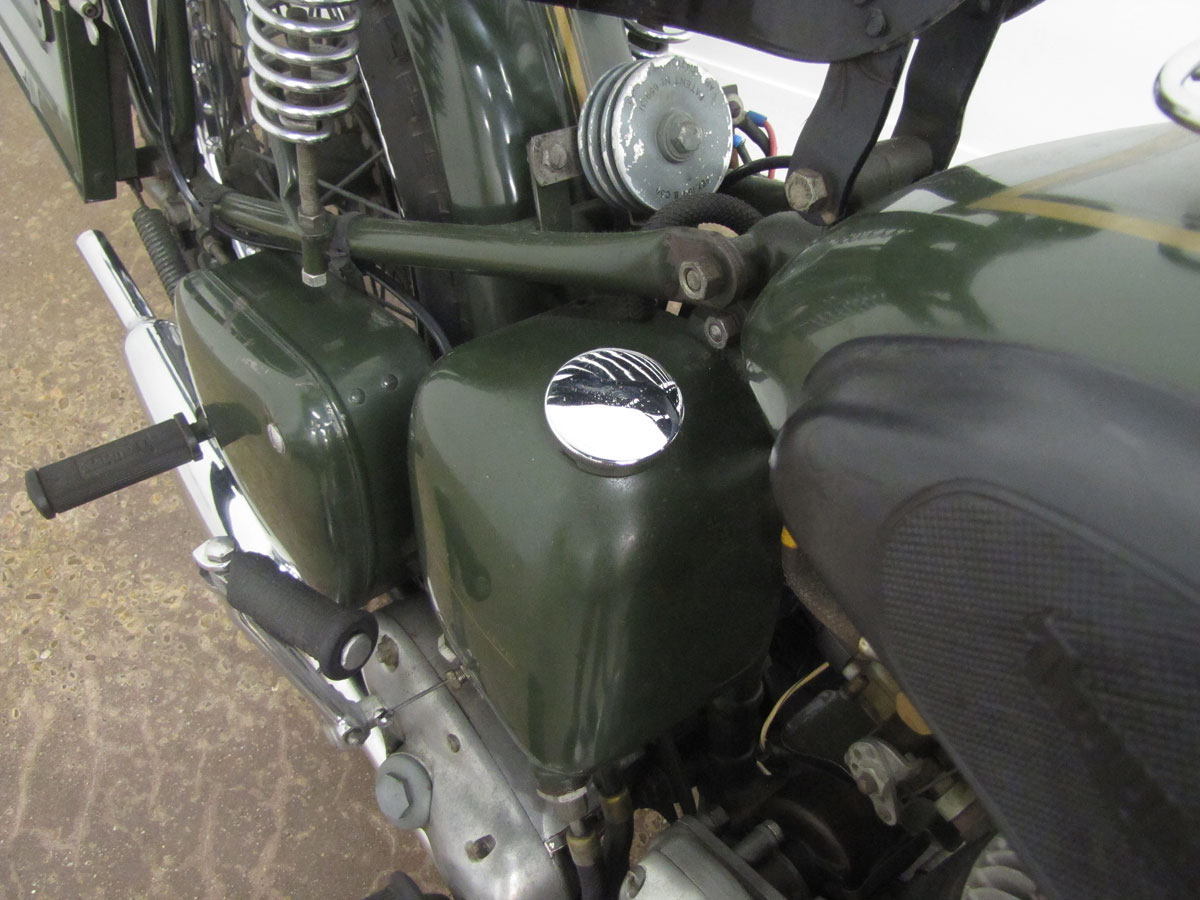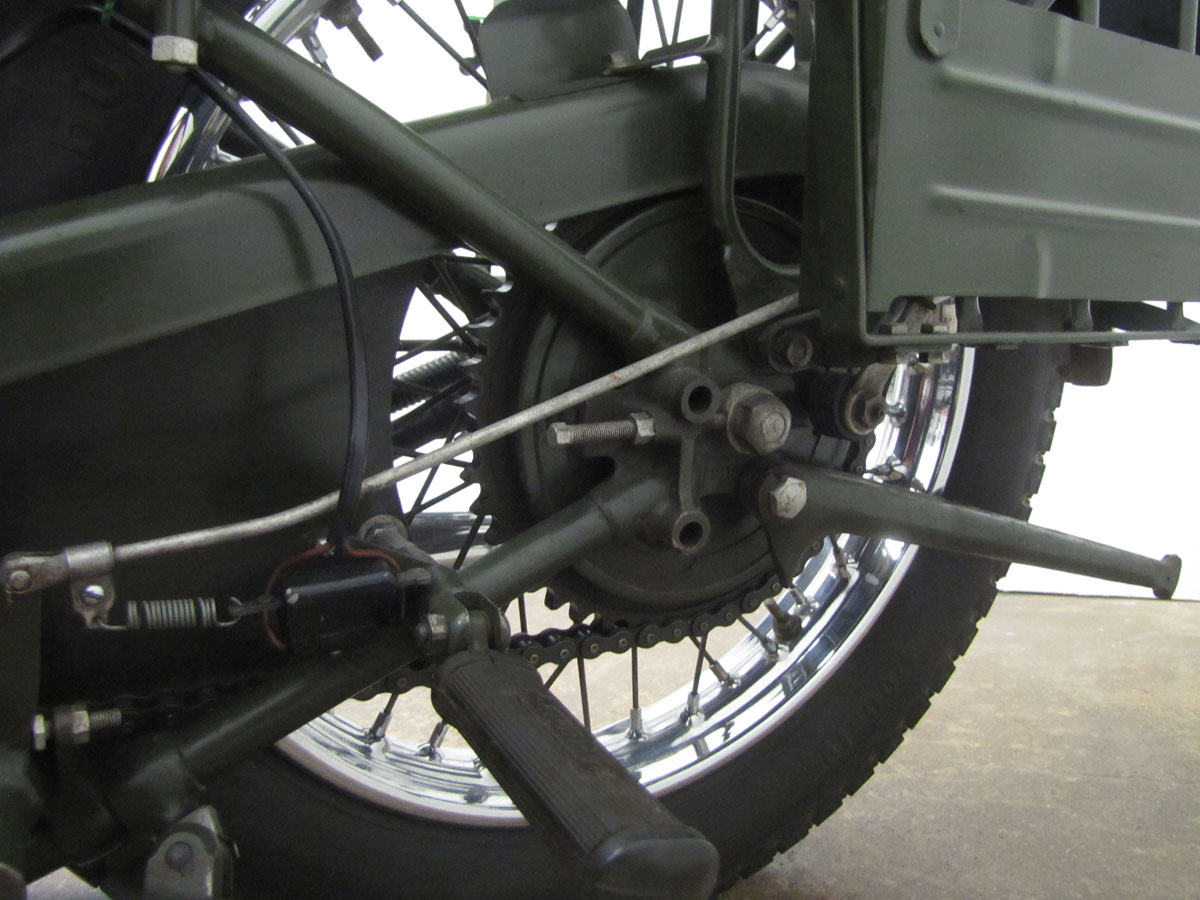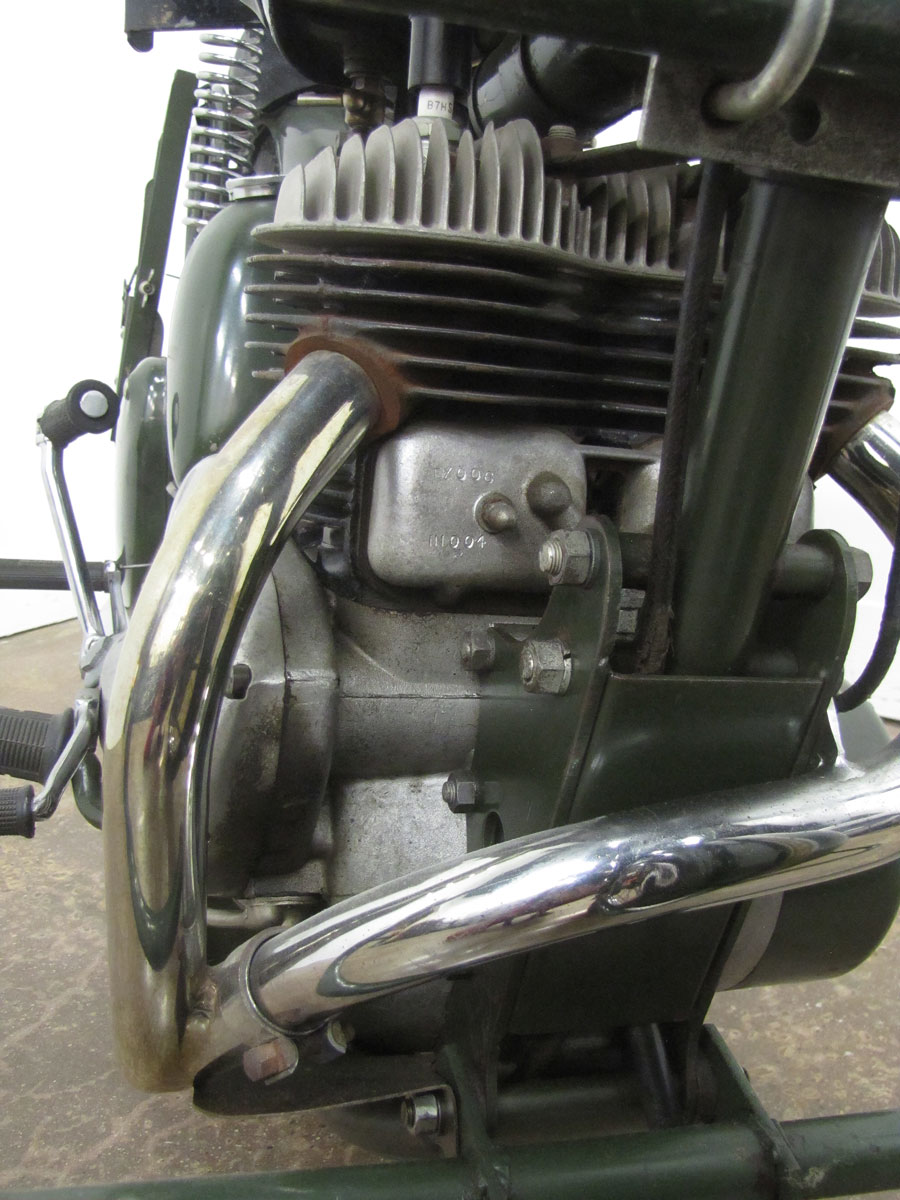
The British Army employed motorcycles as a matter of course, not just in times of war. So before and during World War II a number of machines from BSA, Norton, Royal Enfield and Triumph served a wide range of courier functions, were even tested for some battle services. These riders delivered secret signals, ration messaging and even located and launched carrier pigeons. What the British military learned about durability, service and handling by sometimes less than skilled riders and mechanics was employed in a new military standard. This lead to Triumph designing and building the TRW a couple of years after World War II’s end. Among other things the British Army demanded a motorcycle that could ford 15 inches of water and was inaudible at a half-mile range.
A 500 cc side-valve twin, or flathead, the 5TW prototype, appeared in 1942 from the pen of Bert Hopwood. But it never made production, only inspired the British Government’s Ministry of Supply to request bids for a 500 cc twin capable of better than 70 mph and 80 mpg at 30 mph, with a dry weight of less than 300 pounds and highly effective brakes.
In 1948 Triumph started building the TRW even though the British Army would buy very few by then; the TRW sold well abroad to other military services. A Classic Motorcycle story from January 1994 stated: “In a production run from 1950 to 1964 Triumph turned out 15,939 machines. Some reached other arms of the British services, but the vast majority were exported.”
Using a TR5T Trophy competition chassis, the 500 cc side-valve twin was assembled from cycle parts already in civilian production. This kept production costs down and the assembly lines flowing. A little over spec at 320 pounds, from 1953, it was competitive and, for military duty, was something of a pleasure to ride, still is today. Not being a country to give up on traditions, the British Army Royal Corps of Signals finally abandoned the TRW in 1969.
This very correct original Triumph TRW, though currently missing its seat cover, is on loan to the National Motorcycle Museum by Joseph Gagne.
Specifications:
- Engine: 4-stroke Parallel Twin
- Type: Side-valve
- Displacement: 499 cc’s
- Bore & Stroke: 63 mm x 80 mm
- Induction: 26mm Solex Carburetor
- Electrics/Ignition: Battery, Coil & Points, Alternator
- Primary: Chain Driven
- Transmission: 4-Speed
- Final Drive: Chain Driven
- Horsepower: 16.8HP @ 5,000 rpm
- Brakes: Drum, Front & Rear
- Wheels/Tires: 3.25 x 19 / 3.50 x 19
- Wheelbase: 55 Inches
- Suspension: Telescopic Fork / Sprung Seat
- Weight: 320 Pounds
Leave a Reply
Want to join the discussion?Feel free to contribute!










































i really enjoy the pics, and different angles of display, one question is that seat original?, looks very uncomfortable, or was there originally a leather cover? would appreciate a clarification, u people do a great job, much thanx dennis kranes
Dennis,
The seat is incomplete at the moment. It would have a stitched vinyl cover typical of street Triumphs of the era. Since the bike is on loan, we don’t do any restoration work and figure the owner is on the hunt for a nice original example.
Thanks for writing.
Mark
Would the “Tiger” 500 be the same model? I believe the Triumph ‘basket case” I put back together for my Dad in ’75 was a ’69, and had twin Amal carbs. it had shorty aftermarket exhausts, and had a nice, throaty ROAR! when the throttle was twisted. Didn’t like the dry sump dual piston oil pump, though; very tempermental.
Did the 1950-1951 TRW have a 6.5 inch headlamp? I have what looks to be the fork covers (H799 and H800 in original olive drab color) that match up with a nacelle top from what I think is a 1951 Triumph Thunderbird (original polychromatic blue with Thunderbird decal etc.). This assembly also bolts to my 1958 Triumph T110 but the 7 inch headlight is too large for it. So I figure the headlamp unit for the nacelle must be from the 1950-1951 models. I am also having trouble getting handlebars to fit under the nacelle. I guess I should be using the older versions for the 19501951 models (H659) which parts book show the same for both the TRW and Thunderbird. Can you please clarify these questions (6.5 inch headlamp and handlebar fitment). Looks like it should work with a 6.5 inch headlamp. I can also make it work with a bit of sticky foam weather strip under the fixing ring??? Thanks in advance for any assistance. John B.
Yes 1950 is 6.5 inch. Took a couple tries to find the correct one. They switched to 7 inch later on
Hi,
I have one just like this one. It is a Canadian Army bike as well, and carries the C.A.R. (Canadian Army Registration (tank number) 57-93992. Mine is completely original and has 2442 original miles, original paint, seat cover, tires, etc. Heck, it may even have the original air in the tires! 😉
Great bike! Thanks for sharing.
Rev high!
Alex Sandor Csank (The Dinosaur)
VP, Canadian Vintage Motorcycle Group (Montreal Section)
Vankleek Hill, Ontario, Canada
It seems this bike has a Canadian Military Reg number. Is it possible to get the serial number? I’m trying to “bracket” mine.
I am sorry that bike is on loan – we cannot give out that information on a bike that does not belong to the Museum.
There are books that list the original contract# as it left the factory. Try triumph dating service. Thanks Gary
The original seat was stitched leather with a horse hair mat attached. To register or date your TRW go to Burton bike bits website. I am shopping for original main seat springs some rust is OK. If anyone has a source…thanks.
I have an original spare seat cover if intrested?
Hi Any chance you still have an original Triumph TRW Seat Cover? I really need one. Thanks Randy In Saskatoon Saskatchewan Canada
The original seats were made by Miller who made proprietory seats for various manufacturers. Mine was a ’64 with original seat and panniers.
The seat covers I’ve seen are marked by 2 different companies/suppliers on the metal tags on the back side of the cover… Terry and Lycette are the 2 most common I’ve seen over the years. I still have a spare Terry marked one from parts I collected long ago. Tell me, you have a photo of the tools in the kit for chance? Thanks Gary
I just acquired an origional 57 TRW recently and there are a couple of items I noticed..some of the bikes are stenciled with #s starting with TRW… While this one and mine are #ed the same way year and comyract# ..my bike tank number is only 36 numbers after this one so both of ours are early 57 year productions from factory. Also the handlebar grips look to be on wrong side… Also noticed the PRS8 switch is missing the rubber gromite/weather seal. Mine was missing the rear panniers frames and bags but was able to find some frames and origional mounting brackets for the bottom of the frames along with bags that might be from a later 60’s bike? Finding frames and origional bags are extremely difficult to find as most were made during the 30’s-late 40’s and I’ve heard there are some replacement frames made out of metal tubing that are available from suppliers in parts of India as well as new bags for the Royal Enfield Indian bikes currently made. I’ve even seen origional canvas haversacks used as bags over the years. Buy the Y-straps for the bags are extremely difficult to find as well-thinking I might have to find origional canvas and webbing for straps and to make a set from photos of origional I’ve seen in articles over the years. Overall this is a great resource to see the hard areas and details I don’t see to often in the present day! Thanks
I’m looking to purchase some origional WD literature instruction/workshop/spares manuals as well as some origional panniers and period frames/bags and Y-straps as well as an origional toolkit for this bike..even separate tools would be considered. I have a couple of sets of a 40 Matchless G3 & 41 Matchless G3L warbike toolkits and books for trade if someone has any of the above they wish to consider trading for. Thanks all!
Fond memories of riding these great bikes. You could dump them, pick your self up, straighten the handle bars, and away you go.
I trained on these in the late 60’s with the Irish Army military police. Passed my Final Drive /Test under the watchful eye of a very correct cavalry officer !
Michael O Reilly ex. 6th. Field M P C.